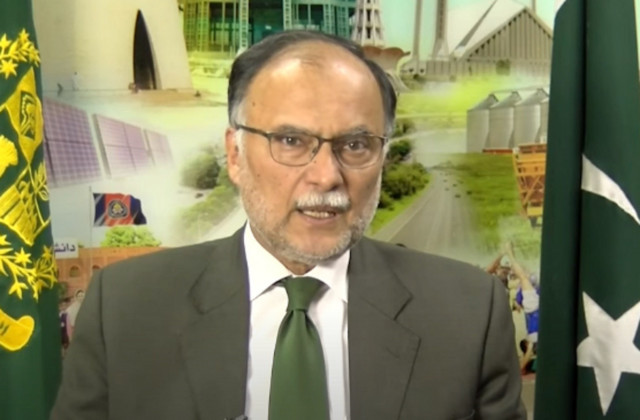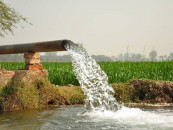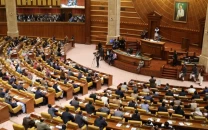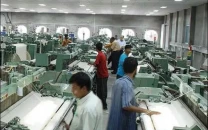97% farmers own less than 12.5 acres of land
7th agriculture and livestock census gives rare insights into rural economy

The latest agriculture census has revealed that Pakistan's 97% farmers own less than 12.5 acres of land and the size of a farm has also shrunk, which the Minister for Planning Ahsan Iqbal says is a matter of concern due to shrinking scale of the economy.
There were only 16,958 landlords in Pakistan who owned more than 100 acres of land and held 6.2% of the total farm land, according to the 7th census that the Pakistan Bureau of Statistics completed after a gap of 15 years. The average landholding by these landlords was 215 acres per person.
The 7th national agriculture and livestock census has given some rare insights about the mostly informal sector of the economy, particularly the trends about usage of water, crops cultivation, land holdings and the livestock penetration in various provinces.
Iqbal officially launched the results of the 7th Agricultural Census 2024 which, he said, was a landmark in Pakistan's statistical history covering Agriculture, Livestock, and Farm Machinery in one report.
The details showed that 97% of the country's total farming community owns less than 12.5 acres of land and suggests that they fall in the low middle to middle income groups. Such small landholdings do not generate enough resources to save money and these poor farmers live crop to crop.
In 2010, 89% farmers had less than 12.5 acres of land. A major reason was the division of inherited land and selling the properties to meet some major expenses, according to people who have conducted the census.
There were 26% farmers who owned even less than one acre of land, a ratio that was just 15% in 2010. About 35% of the total farmers owned less than 2.5 acres of land. In nutshell, 61% farmers have less than 2.5 acres of land, which is not sufficient to ensure decent earnings for these poor people due to outdated farming techniques and low yields.
About 19% farmers had less than five acres of land, which too is too small to generate enough resources for people mostly living in villages with fewer facilities. Another one-tenth of the farmers owned less than 7.5 acres of land and there were hardly 7% farmers who actually owned 12.5 acres of land.
The average size of the farm has reduced from 6.4 to just 5.1 acres, which is a matter of concern, said Ahsan Iqbal while speaking at the launching ceremony. The Planning Minister said that such small sizes reduce the scale of the economy and minimize the prospects of corporate farming.
But he said that overall the results of the census were encouraging and would also positively contribute to the Gross Domestic Product of the country because of the possibility to actually measure the outcomes instead of relying on outdated surveys.
Iqbal said that the findings of the census would help in better planning for lifting the small farmers of the country.
According to the census, there was a significant increase in the cultivated area, which increased to 52.8 million compared to 42.6 million at the time of the last census.
Overall, agriculture remains a key sector of Pakistan's economy, contributing significantly to GDP. Approximately the livelihood of 40 million people is directly linked with agriculture and 37.4% of the Labour Force employed by the sector.
The census showed that there were about 20 million agricultural households, and 98.5% were male heads.
The survey stated that in 2024, Pakistan had around 11.7 million total farms, significantly higher than 8.3 million in 2010. Most farms were owner-operatedabout 10.4 million, compared to 6.74 million in 2010 indicating a strong shift toward farm ownership.
Owner-cum-tenant farms declined to just 550,000 and tenant-only farms also significantly dropped to 770,000, showing a sharp reduction in tenancy-based farming.
Across provinces, Punjab had the highest number of farms at 5.1 million but these were 217,000 less than compared to 15 years ago. One possible reason for the reduction of farm numbers in Punjab was fast urbanization in the province, said Ahsan Iqbal.
The mushroom growth of housing societies can be seen in Punjab and many of these are not properly planned or approved by the land authorities.
The KP has 4.2 million farms, Sindh 1.8 million and Balochistan 630,000 with the majority in each province being owner operated farms. Even in Islamabad, nearly all of the 16,589 farms were owner operated.
Along with an increase in the total number of farms, the total farm area also increased, rising from about 52.9 million acres in 2010 to 59.3 million acres in 2024.
Similarly, the total cultivated area has increased from around 42.6 million acres in 2010 to 52.8 million acres in 2024. On average, each farm in 2024 was about 5.1 acres in size, down from 6.4 acres in 2010. The average cultivated land per farm also decreased from 5.2 acres in 2010 to 4.5 acres in 2024, reflecting the same trend of average farm size.
In 2024, Pakistan's total irrigated area is 45.9 million acres out of total, 14.4 million acres was irrigated by canals, as compared to 12.3 million acres in 2010, according to the census.
A slight decrease was observed in combined irrigation methods, like canals, tube wells, pumps, which reduced to 13.5 million acres in 2024. Punjab has the largest irrigated area with 27.1 million acres in total, followed by Sindh with 7.3 million acres. Although in KP and Balochistan areas are irrigated by canal, other sources are also used. Interestingly, traditional methods like Rod Kohi and Karez are still functional in Balochistan, according to the census.
Non-irrigated (rain-fed) farming saw a sharp decline to 4.9 million acres in 2024, from 8.4 million in 2010, reflecting a shift toward irrigated agriculture nationwide.
Cropped area
Pakistan's total cropped area increased significantly from 68 million acres in 2010 to 82.8 million acre in census 2024, showing a growing confidence in the agriculture sector. The cropped area is more than the 52.8 million total cultivated land because one piece of land can be used multiple times in a year depending upon the crop cycle.
Among all major crops, the share of wheat cropped area remained the dominant crop share in the country, with its contribution rising slightly from 42% to 43.3% in overall Pakistan. Cropping area of rice has seen a slight decline from 14% to 12.9%, while maize increased from 4% to 5.1%.
The cotton share dropped sharply from 14% to 7.9%. Sugarcane share in cropped areas has also declined from 4% to 3.3%. The fodder crop's share slightly increased from 9% to 9.5%.
The chief statistician PBS Dr Naeem uz Zafar explained that livestock has the single largest share of 63.6% in the total agriculture sector, followed by 32.6% share of crops.
Livestock
In 2024, Pakistan's overall livestock population reached 251.3 million, which was significantly higher than the last census of 2006. The chief statistician said that the livestock sector showed an annual growth rate of 3.1% in 2024.
Punjab holds the largest share with 104 million animals, leading in cattle, buffaloes, horses and donkeys population in Pakistan. Balochistan province has 47.9 million total animals out of that 18.8 million were sheep, which is in line with the harsh conditions like scarcity of water.
Khyber-Pakhtunkhwa reported a total 48.7 million animals' population with 22.5 million highest numbers of goats.















1726134115-0/BeFunk_-(41)1726134115-0-208x130.webp)






COMMENTS
Comments are moderated and generally will be posted if they are on-topic and not abusive.
For more information, please see our Comments FAQ